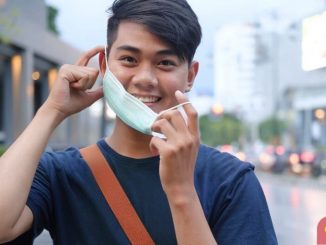
By: Jordan Snobelen, Local Journalism Initiative Reporter, Niagara this Week
Making art can provide a therapeutic outlet for those in health-care settings, facing increasing isolation brought on by the pandemic.
But where art programming was once a group-oriented opportunity to create and socialize with others, therapists have had to adapt to ever-changing restrictions and a move to creating art through a computer screen.
GOING VIRTUAL
Shara McLaren is an art therapist at Hospice Niagara, where the arts programming has moved online.
McLaren says she never imaged spending so much time behind a computer screen as an art therapist, but she’s taken the adjustment in stride.
She prepares art kits which are picked up by participants for weekly art-making workshops dealing with themes surrounding grief, loss and bereavement.
“Pre-COVID, we would be right up next to each other, and there’s some legacy art makings where I’m touching the individuals, I’m manipulating their hands to be able move things around,” she said.
At times, conversations through a computer screen aren’t as fluid as in-person, McLaren admits, but she says while the delivery has changed, it’s taught resilience and provided unexpected insight into the possibilities of virtual art therapy.
Lenore Walker, an art therapist with a local psychology practice, has also managed to adapt to the shift.
“I actually have found the pandemic has given me the advantage of working from my home space which has a small studio integrated,” Walker said.
Some of her clients have been pleasantly surprised by their progression over online sessions and many have expressed wanting to continue virtually after the pandemic wanes.
One of her clients comes prepared with a sketch of what they want to address, and Walker paints it according to the client’s instructions. The finished work is then mailed.
“This has been a very dis-regulating, disconnecting experience for the majority of people, so to be able to do something even virtually together and collaboratively, visually, online has been a great support,” she said.
ARTS RISE TO THE TOP IN MENTAL HEALTH
In Niagara Health’s adult in-patient mental health units, art programming has been profuse throughout the pandemic, said Sarah Kerrigan, a recreational therapist and project co-ordinator working in acute mental health with Niagara Health.
“For quite some time, unfortunately, our department was in an outbreak, so we were not allowed to have any patients gathering whatsoever, so people were in their rooms,” Kerrigan said.
Their daily arts programming has provided a way for people to connect with one another while isolated.
“Humans need connection,” Kerrigan said.
“On the surface, all it looks like we’re doing is painting pictures, but people have massive breakthroughs with their feelings of shame or guilt or things like that.”
CREATIVE COURAGE PUT ON HOLD
At Pathstone Mental Health, focusing on child mental health, staff developed the Creative Courage art project; what was supposed to be a four-instalment art series rolled out across a year.
With only one instalment completed before pandemic lockdowns, the other planned instalments — showcasing graffiti, moulding clay, pastels and charcoal — were put on pause.
“And without it, because of (COVID-19), it’s just added an extra layer to the difficulties of those who are already struggling,” said Kim Rossi, Pathstone’s director of philanthropy. “It is a big loss for sure.”
PHYSICALLY DISTANT
At Hotel Dieu Shaver Health and Rehabilitation Centre and Tabor Manor, a long-term-care home, patients and residents are no longer participating in group art sessions which were often guided by volunteer artists.
“Some people love the social piece of it, as well it was offering a chance to have a conversation as a group,” said Chris Pollard, Hotel Dieu Shaver’s director of rehabilitation services.
Now, people are having one-on-one sessions and art kits are provided to be taken back to rooms.
But Norma Restivo, therapeutic recreation supervisor at Tabor Manor, said they’re coming up with creative ways to keep residents engaged.
On St. Patrick’s Day, residents participated in making decorations for the colourful occasion.




Be the first to comment